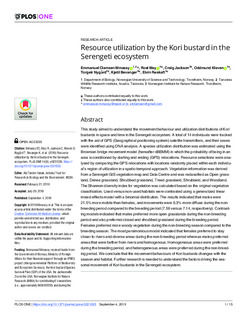Resource utilization by the Kori bustard in the Serengeti ecosystem
Mmassy, Emmanuel Clamsen; May, Roel; Jackson, Craig; Kleven, Oddmund; Nygård, Torgeir; Bevanger, Kjetil; Røskaft, Eivin
Peer reviewed, Journal article
Published version

Åpne
Permanent lenke
http://hdl.handle.net/11250/2619672Utgivelsesdato
2019Metadata
Vis full innførselSamlinger
- Scientific publications [1392]
Originalversjon
10.1371/journal.pone.0221035Sammendrag
This study aimed to understand the movement behaviour and utilization distributions of Kori
bustards in space and time in the Serengeti ecosystem. A total of 14 individuals were tracked
with the aid of GPS (Geographical positioning system) satellite transmitters, and their sexes
were identified using DNA analysis. A species utilization distribution was estimated using the
Brownian bridge movement model (hereafter dBBMM) in which the probability of being in an
area is conditioned by starting and ending (GPS) relocations. Resource selections were analysed
by comparing the GPS relocations with locations randomly placed within each individual’s
region of utilization in a spatio-temporal approach. Vegetation information was derived
from a Serengeti GIS vegetation map and Data Centre and was reclassified as Open grassland,
Dense grassland, Shrubbed grassland, Treed grassland, Shrubland, and Woodland.
The Shannon diversity index for vegetation was calculated based on the original vegetation
classification. Used versus non-used habitats were contrasted using a generalized linear
mixed-effects model with a binomial distribution. The results indicated that males were
21.5% more mobile than females, and movements were 6.3% more diffuse during the nonbreeding
period compared to the breeding period (7.59 versus 7.14, respectively). Contrasting
models indicated that males preferred more open grasslands during the non-breeding
period and also preferred closed and shrubbed grassland during the breeding period.
Females preferred more woody vegetation during the non-breeding season compared to the
breeding season. The most parsimonious model indicated that females preferred to stay
closer to rivers and diverse areas during the non-breeding period whereas males preferred
areas that were farther from rivers and homogenous. Homogeneous areas were preferred
during the breeding period, and heterogeneous areas were preferred during the non-breeding
period. We conclude that the movement behaviours of Kori bustards changes with the
season and habitat. Further research is needed to understand the factors driving the seasonal
movement of Kori bustards in the Serengeti ecosystem.
